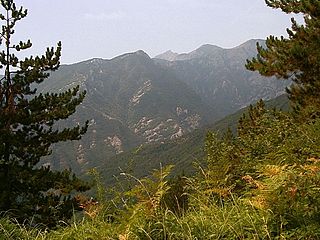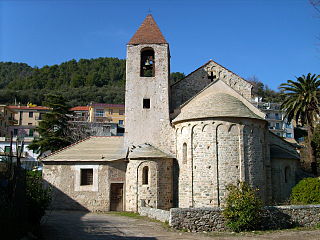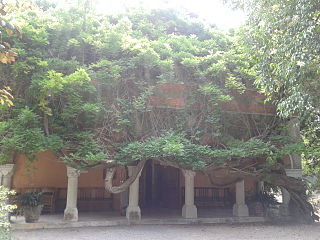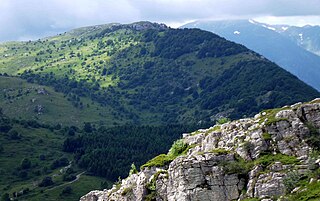
The Italian Riviera, or Ligurian Riviera, is the narrow coastal strip in Italy which lies between the Ligurian Sea and the mountain chain formed by the Maritime Alps and the Apennines. Longitudinally it extends from the border with France and the French Riviera near Ventimiglia eastwards to Capo Corvo which marks the eastern end of the Gulf of La Spezia and is close to the regional border between Liguria and Tuscany. The Italian Riviera thus includes nearly all of the coastline of Liguria. Historically the "Riviera" extended further to the west, through what is now French territory as far as Marseille.
The Ligurian language was spoken in pre-Roman times and into the Roman era by an ancient people of north-western Italy and current south-eastern France known as the Ligures.

The Ligures were an ancient population that gave the name to Liguria, a region of north-western Italy.
Brigasc is a dialect of the Ligurian language. It is spoken in Italy and France.

The Ligurian Alps are a mountain range in northwestern Italy. A small part is located in France. They form the south-western extremity of the Alps, separated from the Apennines by the Colle di Cadibona. The Col de Tende and the Vermenagna valley separate them from the Maritime Alps. They form the border between Piedmont in the north and Liguria in the south.

Bordighera is a town and comune in the Province of Imperia, Liguria (Italy).

Monte Saccarello (Italian) or Mont Saccarel (French) is a mountain located on the French-Italian border between Liguria, Piedmont and Provence-Alpes-Côte d'Azur.

Clarence Bicknell was a British vicar, amateur archaeologist, botanist, artist, Esperantist, author and philanthropist. He founded the Bicknell Museum in Bordighera, Italy. Also named after him is a street in Bordighera, and two plant species.

San Paragorio is a church located outside the Medieval walls of the town of Noli, province of Savona. It is an important monument of Romanesque architecture and it is ranked among the most beautiful buildings of this style to be seen in Liguria. It is an Italian national monument since 1890.

The Archaeological Museum of Savona is located in Palazzo della Loggia inside the Priamar Fortress. It presents the history of the Priamar promontory and the town of Savona. On the exposition are old collections of objects from around the Mediterranean and artifacts from the 20th century excavations of the fortress and its surrounding. The museum has two floors and inside it is possible to see original excavation pits.

The Alta Via dei Monti Liguri is a long-distance waymarked hiking trail in the Italian region of Liguria. In about 440 kilometres (270 mi) and 44 day hikes, it runs through the arc formed by Ligurian Alps and Ligurian Apennines from Ventimiglia to Ceparana.

Cima Garlenda is a 2141 m mountain of the Ligurian Alps, in Italy. After Monte Saccarello and Monte Frontè it is the third Ligurian summit.

The Arene Candide, is an archaeological site in Finale Ligure, Liguria, Italy. Its name was derived from the eponymous dune of white (candida) sand (arena) that could be found at the base of the cliff until the 1920s in the Caprazoppa promontory, where the Arene Candide cave is located.

The Clarence Bicknell Museum is a small concealed building at 39 Via Romana in Bordighera. This is often referred to as its official address, but the large villa is the seat of the International Institute of Ligurian Studies. To the right of the building is via Clarence Bicknell, leading to the entrance of the gardens of the villa and of the museum. The two buildings are part of the same block. In 1888, Clarence Bicknell built the museum to collect, preserve, and exhibit his archaeological and botanical collections.

Edward Elhanan Berry was the son of Edward Berry (1817-1875), lawyer and owner, and of Ada Bicknell (1831-1911) sister of Clarence Bicknell. Edward was born on May 10, 1861 in Kingston, Canada. Little is known about his childhood, we know only that he returned to London still as a child. He graduated around 1880, it is unknown exactly in which faculty he enrolled, probably a scientific one, because he was later a member of the "Royal Society of Chemistry."

Caroline Jane Goodson is an archaeologist and historian at the University of Cambridge, previously at Birkbeck College, University of London. In 2003 she won the Rome Prize for medieval studies of the American Academy in Rome. In archaeological work, Goodson is most closely associated with the Villa Magna site in Italy where she has been field director since 2006.

Monte Armetta is a mountain in Piedmont, northern Italy, part of the Alps. At an altitude of 1,739 metres is the highest summit of the Ligurian Prealps.

Monte Monega is a 1,882-metre (6,175 ft) mountain of the Ligurian Alps, in Italy.

Istituto Nazionale di Studi Etruschi ed Italici is a cultural institution based in Florence, Tuscany, Italy. It was founded in 1925 with the aim of promoting and enhancing in Italy and worldwide studies on the Etruscan civilization and other peoples of ancient Italy.

The Italian Numismatic Institute is an Italian body for the study of numismatics, based in Palazzo Barberini at 13 via Quattro Fontane.


















